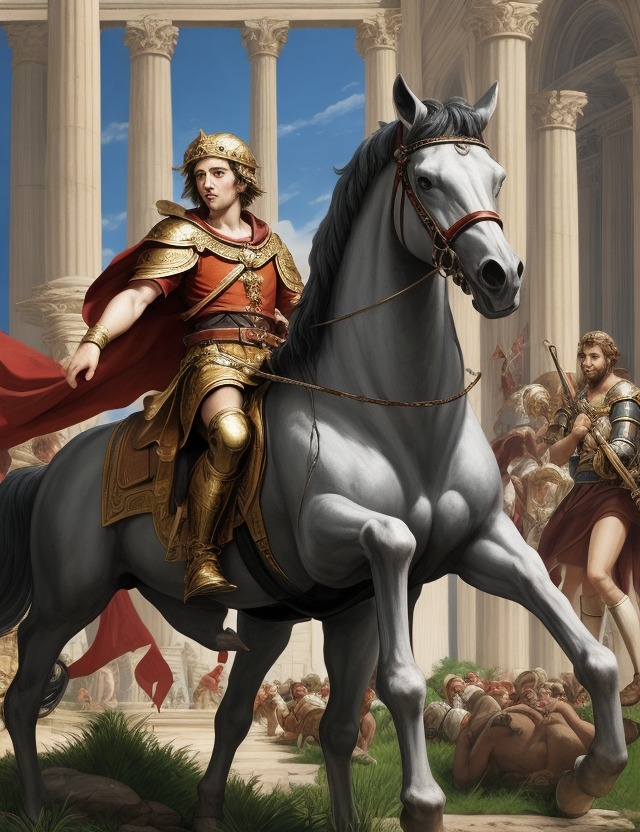Unlock the epic journey of a hero that has withstood the test of time. Delve into the captivating classic world of ‘The Aeneid’, penned by the prominent Roman poet, Virgil. This literary masterpiece, sweeping across centuries, transcends boundaries as it weaves a tale of destiny, love, and war. Intrigue awaits as you embark on an unforgettable quest alongside Aeneas, the Trojan hero, driven by his unyielding determination to fulfill an ambitious prophecy.
Join us on a captivating exploration of this ancient epic, enhanced with insightful analysis and historical context.
Short Summary of The Aeneid
Once upon a time, in a land far away, there was a brave and noble hero named Aeneas. He lived in the ancient city of Troy, among a people who were known as the Trojans. Aeneas was a strong and courageous warrior, but he was also kind-hearted and wise.
One day, the Trojans faced a terrible enemy in the form of the Greeks. The Greeks surrounded Troy with their mighty army, and a long and fierce war began. Aeneas fought valiantly to protect his city and its people, but despite their bravery, the Trojans were eventually defeated.
As the city burned to the ground and its people scattered in all directions, Aeneas knew that he must find a new home for his fellow Trojans. He embarked on a journey, with his young son Ascanius and a group of faithful followers, in search of a place where they could start anew.
Their journey was filled with countless obstacles and adventures. They faced treacherous storms at sea, encountered fierce monsters, and visited enchanted islands. Aeneas, guided by the gods, led his people through all these challenges with determination and bravery.
On their journey, Aeneas and his companions came across the beautiful city of Carthage, ruled by the famous Queen Dido. Aeneas and Queen Dido fell deeply in love, and they spent blissful days together. However, the gods reminded Aeneas of his destiny to found a new city, and he knew he must continue his journey.
With a heavy heart, Aeneas left Queen Dido and set sail once again. He and his Trojans faced many more trials and tribulations, but they never lost hope. Eventually, they reached the shores of Italy, where Aeneas knew their new home awaited.
However, the land was not empty. It was ruled by King Latinus, who had a daughter named Lavinia. Aeneas and King Latinus formed an alliance and agreed to marry Aeneas to Lavinia. This caused tension with Turnus, a warrior prince who also desired Lavinia’s hand in marriage.
War broke out between Aeneas and Turnus, with both sides displaying great bravery and skill. The gods played a part in deciding the outcome of the battle, and in the end, Aeneas emerged victorious. He mourned the loss of many brave warriors but knew that this was the way of war.
With peace restored, Aeneas founded a new city named Lavinium, in honor of his beloved wife. He became its king and ruled wisely, creating a thriving civilization. The Trojans, who had once been refugees, now had a new home to call their own.
But Aeneas’s journey was not yet complete. The gods revealed to him that he was destined to found another city, even greater than Lavinium. This city would be called Rome, and it would be the heart of a mighty empire that would last for centuries.
Aeneas passed on his legacy to his son Ascanius, who would lead the Trojan people to eventually found Rome. Thus, Aeneas fulfilled his destiny and became the hero for generations to come. His story would be told for centuries, inspiring countless others to acts of bravery and courage.
And so, dear children, the tale of Aeneas and his epic journey comes to an end. It teaches us the importance of perseverance, loyalty, and the belief in a greater destiny. Aeneas never gave up, even in the face of immense challenges, and he showed us that with courage and strength, we can overcome even the most difficult of circumstances.
So, remember the story of Aeneas, and let it inspire you to face life’s obstacles with bravery and determination. For within each one of us lies the potential to become a hero, just like Aeneas.
The End
The Aeneid: Key Themes
The Aeneid, written by the Roman poet Virgil, is an epic tale that explores the foundation of Rome and the journey of its hero, Aeneas. This epic poem serves as both a tribute to Roman history and a reflection on the values and ideals of ancient Roman society. The Aeneid is divided into twelve books, and within its pages, three key themes emerge: destiny, piety, and the tension between duty and personal desires.
The first prominent theme throughout The Aeneid is destiny.
Aeneas, the protagonist and the Trojan hero, is fated to found Rome as ordained by the gods. He faces numerous trials and challenges as he tries to fulfill his destiny. The gods play a crucial role in determining Aeneas’ path, guiding and manipulating events to ensure the fulfillment of his mission. The motif of destiny serves to emphasize the importance of divine intervention in shaping human lives and the inevitability of fulfilling one’s predetermined fate.
The second theme is piety.
Aeneas is depicted as a devout and virtuous hero who always seeks to honor the gods and fulfill his religious duties. He carries with him the sacred fire of Troy, symbolizing his commitment to preserving his people’s religious traditions. Throughout the epic, Aeneas is tested in his piety, particularly in the face of personal tragedy and adversity. This theme highlights the significance of piety and religious observance in Roman society, emphasizing the importance of maintaining a strong connection with the gods.
The third key theme in The Aeneid is the tension between duty and personal desires.
Aeneas consistently faces internal conflicts as he must balance fulfilling his destiny and his personal desires. He is torn between his duty to his people, his family, and his desire for personal happiness and love. The most significant example of this conflict arises in Book IV, where Aeneas falls in love with Dido, the queen of Carthage. Aeneas’ love for Dido threatens to distract him from his divine mission, and he grapples with the consequences of his choices. This theme underscores the value that Roman society placed on duty and sacrifice for the greater good, reflecting the virtues of loyalty, perseverance, and self-sacrifice.
In summary, The Aeneid explores destiny, piety, and the tension between duty and personal desires. These themes intertwine as Aeneas navigates his journey, facing challenges and struggling to fulfill his divine mission while remaining true to his religious and moral principles. With these themes, Virgil provides a profound reflection on the values and ideals central to Roman society, presenting the foundation of Rome as both a divine destiny and a product of human endeavor.
The Aeneid: Characters
1. Aeneas: The valiant hero of the epic, Aeneas is a Trojan prince destined to found Rome. He possesses a regal stature, with broad shoulders and a chiseled jawline, exuding an aura of nobility. Known for his unwavering loyalty and courage, Aeneas embarks on a treacherous journey as he navigates his way through encounters with mythical creatures, vengeful gods, and heart-wrenching tragedies. Ironically, he proves to be the epitome of stoicism and resilience, even as he faces heartbreak and loss.
2. Dido: The passionate and tormented Queen of Carthage, Dido captures the hearts of both readers and characters alike. With a striking beauty that rivals even the most radiant goddesses, her long, flowing dark hair frames a face adorned with sparkling emerald eyes. As she falls hopelessly in love with Aeneas, Dido is known for her fiery temperament and her inability to control her emotions, leading to both her ultimate downfall and despair.
3. Juno: The powerful queen of the gods, Juno possesses a regal elegance and allure. Often depicted with bright, piercing blue eyes, she exudes an air of authority and cunning intellect. Known for her relentless hatred towards the Trojans, Juno orchestrates cunning schemes and manipulations, using her magical powers to hinder Aeneas and divert him from fulfilling his destiny. Despite her villainous actions, there is a melancholic depth to Juno, as she grapples with a profound sense of loneliness and unfulfilled desires.
4. Venus: A divine goddess of love and beauty, Venus radiates an otherworldly aura. She possesses a celestial grace, with flowing golden locks cascading down her perfectly sculpted shoulders. Imbued with an ethereal elegance, Venus is known for her unwavering love and protection for her son, Aeneas. As she intervenes on Aeneas’ behalf, she harbors a motherly sweetness and warmth, providing guidance and divine assistance in his treacherous journey.
5. Turnus: The fearless Rutulian warrior and Aeneas’ rival for Lavinia’s affections, Turnus embodies brute strength and raw masculinity. With a towering presence, his muscular physique is complemented by a rugged beard and a perpetually furrowed brow. Known for his impulsive nature and battle prowess, Turnus displays a fierce determination to defend his honor and claim his rightful place as Lavinia’s suitor, which culminates in dramatic confrontations and intense clashes throughout the narrative.
6. Laocoon: The wise and fateful Trojan priest, Laocoon possesses a distinctive, aged appearance. His greying beard frames a face lined with wisdom and experience, while his weary eyes reflect a deep understanding of the hidden machinations of the gods. Laocoon is portrayed as a tragic figure, as his attempts to warn the Trojans about the Trojan Horse and avert their doom are met with cruel consequences. A symbol of the anguish caused by human disbelief and divine retribution, Laocoon’s character serves as a poignant reminder of the consequences of hubris.
7. Ascanius: The young son of Aeneas, Ascanius is the embodiment of youthful innocence and potential. With his cherubic countenance and bright, curious eyes, he radiates an infectious joy that offers respite amidst the chaos of the epic. Ascanius serves as a symbol of hope for the future of Rome, offering a glimmer of light even in the darkest moments.
8. Pyrrha: A faithful friend of Aeneas, Pyrrha is a resilient and resourceful Trojan woman. With her fiery red hair cascading down her back, she possesses an energetic spirit and a mischievous charm. Pyrrha plays a supporting role in the narrative, offering both emotional support and indispensable aid to Aeneas during his arduous journey.
9. Polyphemus: The infamous Cyclops, Polyphemus is a towering creature with a single, monstrous eye in the center of his forehead. Known for his insatiable appetite and brute strength, his physical appearance is both grotesque and awe-inspiring. Polyphemus plays a memorable role in the epic, serving as a fearful opponent for Aeneas and his companions during their journey, culminating in a dramatic confrontation between the hero and the mythical creature.
10. Anchises: Aeneas’ wise and aged father, Anchises radiates a dignified aura and an air of profound wisdom. With his long, grey beard and deeply lined face, his appearance bears the weight of his experiences and knowledge. Despite being burdened by his old age, Anchises’ character is rich in wisdom, imparting crucial insights and prophecies to Aeneas, transforming him into a leader capable of guiding his people to greatness
The Aeneid: Symbols
1. The Trojan Horse: The Trojan Horse is one of the most iconic symbols in The Aeneid. It represents both deception and destruction. In the epic, the Greeks construct a massive wooden horse as a gift to the Trojans but hide a select group of soldiers inside. The Trojans accept the horse, unknowingly bringing their own downfall. The symbolic significance lies in the idea that things are not always as they seem, and that trust can be easily manipulated. It serves as a cautionary tale about the consequences of naivety and the need for vigilance.
2. The Golden Bough: The Golden Bough is a symbol of Aeneas’ journey to the underworld. The Sibyl, a prophetess, tells Aeneas that in order to gain access to the underworld, he must find a golden bough growing in the nearby forest. This bough acts as a passport, allowing Aeneas to navigate the world of the dead safely. It symbolizes his connection to the divine and his ability to undertake a spiritual quest. The search for the Golden Bough also signifies Aeneas’ determination and his willingness to confront the challenges that lie ahead.
3. Fire: Fire is a recurring symbol throughout The Aeneid, representing both destruction and purification. In the epic, fire is often associated with the wrath of the gods. For example, when the Trojans are attacked by the Greeks, their homes are set ablaze, and they are forced to flee their city. Additionally, in the epic’s final battle, the fiery wrath of Turnus proves to be his downfall. On the other hand, fire is also used to symbolize purification and rebirth. For instance, Aeneas and his men burn their ships upon arriving in Italy, symbolizing their commitment to their new homeland. Fire, in this sense, represents the destruction of the old and the emergence of the new, reflecting the themes of transformation and renewal present in The Aeneid.
The Aeneid Moral Lesson
The Aeneid is an epic poem written by the Roman poet Virgil. The moral lesson of the Aeneid is that perseverance, determination, and piety are virtues that lead to success. The story follows the journey of Aeneas, a Trojan hero, who travels to Italy to establish a new home for his people. Along the way, he faces many challenges and obstacles, but he perseveres through them all with the help of the gods. The Aeneid teaches us that even in the face of adversity, we must remain steadfast in our beliefs and continue to work towards our goals.
The Aeneid: Culture Impact
The Aeneid, a timeless classic written by the renowned Roman poet Virgil, has left an indelible mark on our literary and cultural landscape. First published in 19 BCE, this epic poem has not only shaped the understanding of ancient Rome but has also exerted a profound influence on subsequent generations of writers, artists, and thinkers.
Historically, The Aeneid played a crucial role in solidifying Rome’s national identity, as it narrates the mythical origins of Rome and glorifies its heroes. Virgil sought to connect Rome’s past with its contemporary political context by linking the legendary Trojan prince Aeneas to the founding of Rome itself. Through Aeneas’s heroic journey, the poem not only reinforces the idea of Rome’s divine destiny but also instills a sense of pride and purpose in the minds of its citizens, cementing the belief that Rome is destined for greatness.
The cultural impact of The Aeneid extends far beyond its historical significance. Its influence can be seen throughout various art forms, literature, and even pop culture. The theme of destiny and fate, as depicted in the poem, has resonated with countless authors, inspiring numerous works of literature exploring similar themes. From Dante’s Divine Comedy, which drew heavily from The Aeneid’s structure and imagery, to the modern-day retellings and adaptations of the Trojan War and hero narrative in popular books and movies, the lasting legacy of Virgil’s epic is undeniable.
The Aeneid’s impact on language and rhetoric is also noteworthy. Virgil crafted his poem with meticulous attention to detail, employing beautiful and evocative language that became a model for subsequent Latin literature. His verse influenced generations of poets and writers, and its enduring quality can still be appreciated today. Additionally, The Aeneid’s poetic style, characterized by vivid descriptions, emotional depth, and a carefully structured narrative, set a high bar for epic poetry, paving the way for the likes of Ovid, Milton, and other masters of the genre.
Moreover, The Aeneid’s impact is not limited to its serious and weighty themes. Virgil masterfully injects humor and wit into the narrative, providing welcome relief from the intensity of the hero’s journey. From the mischievous gods meddling in mortal affairs to the bumbling antics of the Trojan warriors and the witty banter between characters, Virgil’s subtle humor adds depth and multidimensionality to his epic. This infusion of comedy amidst grandiose themes has influenced later works, highlighting the potential for humor in serious literature.
In terms of achievements, The Aeneid has had an extraordinary reception and has been revered as one of the greatest works of Western literature. It has been translated into numerous languages, enabling its reach to extend far beyond its original Roman audience. Its enduring popularity and profound impact on subsequent literature and culture have made The Aeneid a cornerstone of classical education, ensuring its place in the canon of world literature.
In conclusion, The Aeneid’s cultural impact cannot be overstated. From shaping Rome’s national identity to influencing countless generations of artists and writers, this epic poem has left an indelible mark on human culture. Its historic significance, comedic elements, linguistic achievements, and profound themes have secured its place as a masterpiece that continues to captivate and inspire readers to this day.
FAQs
1) What is The Aeneid about?
The Aeneid is an epic poem written by the Roman poet Virgil. It tells the story of Aeneas, a hero of the Trojan War, who flees the burning city of Troy and embarks on a long journey to Italy. The poem explores themes of destiny, fate, and the foundation of Rome.
2) Is The Aeneid similar to The Iliad and The Odyssey?
Although The Aeneid shares some similarities with The Iliad and The Odyssey, such as its epic nature and exploration of heroic ideals, it is a distinct work on its own. While The Iliad and The Odyssey focus on the Greek heroes and their experiences, The Aeneid centers around Aeneas and his journey, ultimately serving as a national myth for the Romans.
3) How long is The Aeneid?
The Aeneid consists of 12 books, which are divided into individual sections called “books” as well. In total, the poem contains approximately 9,900 lines of Latin verse.
4) When was The Aeneid written?
Virgil wrote The Aeneid between 29 and 19 BCE, during the reign of Roman Emperor Augustus. The poem was completed just before Virgil’s death and was published posthumously.
5) Is The Aeneid still widely read today?
Yes, The Aeneid remains widely read and studied today, both for its literary and historical significance. It is considered one of the foundational works of Western literature and has had a significant influence on subsequent literary, artistic, and cultural works.










